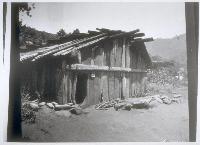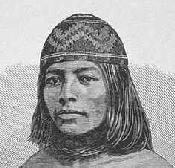
Yurok
Literature
"When you die, you will be spoken of as those in the sky, like the stars."

"When you die, you will be spoken of as those in the sky, like the stars."
They used redwood dugout canoes to travel in their territory, and to reach their neighbors, the Hupa and the Karok, for trade and socialization. They supplied canoes to these people, as well as dried sea foods and shells. The Hupa also traded with the Shasta and the Wiyot nearby. The Yurok got skins from the Hupa, the Shasta and the Wiyot, and from the Karok they got dentalium shell, which has that name because it looks like a tooth. These shells were valuable to the people of this area, and were used as money. They also obtained abalone shell by a trading chain that reached to the south.
They lived in houses made of redwood or cedar, which have natural preservative oils in them, and would last a long time in the rainy climate. The Yurok had a way of life very similar to the Hupa and Karok. An unusual aspect of their culture is that a house site or a fishing site would have been privately owned, which is not common for Native American people. Kroeber thought that the original population of the Yurok might have been about 2500 people.
Yurok people still live in California, and they have several reservations in Northwest California, the Smith River Rancheria, the Elk Valley Rancheria, and the Resighini Rancheria in Del Norte County, and the Yurok Reservation, the Big Lagoon Rancheria, and the Tsurai (Trinidad) Rancheria in Humboldt County.
Amy Smoker, a Yurok weaver born in 1897 created baskets that are still used in ceremonies. One of her creations is shown in the California Native American Calendar for 1998 by Press.
The main traditional/religious rites are the World Renewal Ceremonial Cycle and include the White Deerskin Dance and the Jump Dance.

They made ropes of sinew; then the twelve watched until the Sun, as he followed the downward trail in the sky, touched the top of a certain hill.
Then the Foxes caught Sun, and tied him fast to the hill. But the Indians saw them, and they killed the Foxes with arrows. Then they cut the sinews.
But the Sun had burned a great hole in the ground. The Indians know the story is true, because they can see the hole which Sun burned.